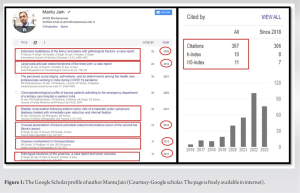Dr. Mantu Jain, 102/J, Cosmopolis, Dumduma, Bhubaneswar, Odisha, India. E-mail: montu_jn@yahoo.com
Case reports (CR) are essential for documentation, particularly for managing rare diseases, presenting a new/emerging disease, reporting adverse reactions to a medication, or sometimes sharing novelty among medical professionals [1]. However, they are a matter of impugn between the journal editors on one side and the researcher and the clinician on the other.
The advent of impact factor (IF) as a tool to determine the academic status of journals and the evolution of the evidence-based pyramid has pushed many journals into the muddy rat race of claiming supremacy over other journals. CR is less cited and, therefore, reduces the total IF of the journal [2]. Additionally, the perception that CR and case series form the lowest rung of the evidence pyramid has progressively led to most journals shying away from CR. The result is the burgeoning numbers of armchair researchers replacing hard-worked original clinical and basic science studies with meta-analysis and systematic reviews, often concluding in ambiguous statements like “more studies are required to…”. Some journals have an ornamental CR section allowing 1-2 CRs, while many have already done away with this section. Some even have mentioned in the author’s guidelines that CR is no longer accepted in their journal. This might appear paradoxical in an era where most journals are published online, often solely so, and the number of submissions is (at least theoretically) unlimited. But do CRs negatively influence the IF of a journal? Interestingly, Erivan et al. did a bibliometric study of the effect of the CR on the IF of journals. The authors found that mean IF would have improved from 2.013 to 2.072 (p-value- 0.00001 and therefore statistically significant) without CR. Academicians have long debated “questionable editorial policies that affect the IF of journals,” like manipulating the denominator, coercive citations, etc. The real question is – Are the journals truly meant to compete for IF in the name of publishing high-quality original research only? Clearly, the core purpose of disseminating scientific/medical knowledge amongst peers may be lost in this battle, and the journals would be restricted to a handful of select contributors and readers (the elite club).
A researcher has to be perceived as an ever-evolving entity. In their formative years, most clinical students start reading CR as they search for similar cases for diagnosis, investigations, and management, all of which are given in precise detail. CR is also an initial article for many of them as they enter the publishing world. Unfortunately, several academic institutions and organizations have shunned CR for one reason or another. CR is typically not even counted as a publication for authors. Therefore, many authors move away from CR while only a few hold on to the old passion and keep publishing CR, often at considerable financial expense. Can a CR contribute to a researcher or author? The h-index and I-10 index are the recent critical parameters for measuring the research abilities of authors and journals. Here is an example of the author’s (MJ) Google profile (Fig. 1). The figure clearly illustrates that CRs are high in citation and have contributed substantially to the author’s higher indices. One can argue that CR, having higher citations, was published long ago. The journey of every researcher progresses from CR to the original articles and studies higher up in the evidence pyramid. The IF considers two or five years into the calculation, but CRs are also frequently cited in the long run and are beneficial for journals.
A clinician, meanwhile, is a mute spectator in this ongoing transformation. The publishing world conundrum is snatching away his opportunity for scientific knowledge in the form of CR. CR is a valuable learning resource to enhance his clinical knowledge and analytical skills that ultimately affect patient care [3]. A medical undergraduate or post-graduate student who is a new entrant to the “world of research” would first dive into the CR section as they are most easily relatable to their daily life. Even there is a paradigm shift in medical education from traditional teaching to case-based and problem-solving scenarios. CR is a complete package to give intricate details to any situation. For example, if a CR discusses the differential diagnosis of a disease. It will include the commoner to the rarest possibility.
Originally meant to disseminate knowledge among medical professionals, journals have de facto become a staggeringly profitable business model rivalling the film and music industries. This trend, in turn, unfortunately, reflects the global career imperatives to publish or perish. The need for objective criteria to monitor the quality of such outputs is, therefore, increasingly necessary to stratify the players in the market. But in the bargain, are they losing the wide readership once enjoyed to select “intellectuals”? Many journals have issued a death sentence to CR, but few journals (JOCR is one of them) have given a fresh lease of life by exclusively publishing CRs. JOCR articles are archived in PubMed, and being an open access journal, they give easy opportunity for reading and citations.
References
- 1.Kidd M, Hubbard C. Introducing journal of medical case reports. J Med Case Rep 2007;1:1 [Google Scholar]
- 2.Mason RA. The case report--an endangered species? Anaesthesia 2001;56:99-102. [Google Scholar]
- 3.Wong KC. Using an Ishikawa diagram as a tool to assist memory and retrieval of relevant medical cases from the medical literature. J Med Case Rep 2011;5:120. [Google Scholar]
- 4.Erivan R, Dartus J, Villatte G, Marcheix PS, Descamps S, Boisgard S. Bibliometric analysis of case report citations and their effect on the impact factor: How does publishing case reports impact journals? Orthop Traumatol Surg Res 2020;106:1463-7. [Google Scholar]









